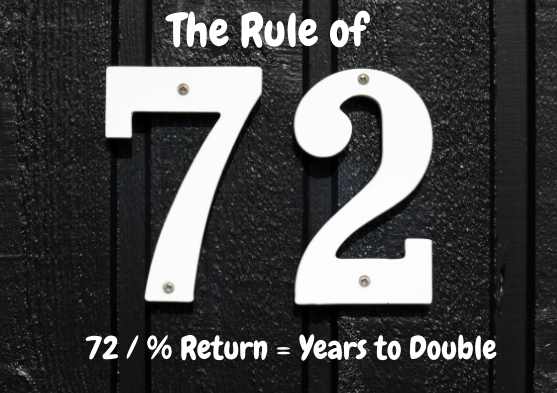Intro
Rules, rules, rules!!!! The world of personal finance loves ’em! 😂
Broadly defined, the “Rule of 72” is a quick way of determining how long it will take an investment to double in value with a given fixed rate of return. This is often used when doing “back of the napkin math,” or figuring a quick calculation mentally. Just like many “rules” of personal finance, this is a rule of thumb and should only be applied as such.
Due to its simplicity, the Rule of 72 is a great tool for Savvy Solos to come up with a savings goal with investments, or to approximate the impact of compound interest working against you. In general, its best applied to interest rates between the range of 6% – 10%.
How It Works
72 / % Return = Years to Double
Basically, all you have to do is divide 72 by the expected rate of return to get how long it will take to double. For example, if we have a diversified portfolio and can safely assume a 7% annual return, this is what it would look like:
72 / 7 = 10.28
In this case our investment would likely double in a little over 10 years. If we currently had $100,000 invested, we would assume it would become $200k in year 10, $400k in year 20, $800k in year 30, and so on and so forth. This is of course assuming the 7% annualized return is reinvested for compound interest, and the original investment of $100k is left untouched.
Given that the past decade performance of VTSAX is currently showing 12.49%, many people will use 10% as the safe annualized return. I’m not recommending using a 10% return, but it’s fun to play with the numbers. This would mean that your investment is doubling every 7.2 years!
So, in essence, let’s say a 30-year-old did a good job saving in their 20s and has $100k invested with the VTSAX and Chill strategy. Without adding another dime to this investment, this Savvy Solo would presumably have $3.2 MILLION at the age of 66! 😶👀😶 Talk about a comfortable retirement huh? 😂
Inflation
Naturally, the first question one might have is “WHAT ABOUT INFLATION!?!?!?!!?!!?!?”
Inflation, and other factors, are going to decrease our buying power in the future. We can utilize the Rule of 72 to factor this in. Inflation has averaged 2.3% over the last 10 years, with the last few years getting really wonky on us. For the sake of playing conservatively, let’s assume 2.5% inflation rate moving forward.
72 / 2.5 = 28.8
This means that our buying power is essentially going to be cut in half approximately every 29 years. Keeping things simple, that $3.2 mil might be looking more like $1.5 mil in today’s dollars. 😬 Still, a Savvy Solo looking to retire today with $1.5 million invested is looking pretty comfortable!
The Rule of 72 could also be utilized to factor GDP growth, interest rates on debt, and (heaven forbid) AUM fees by financial advisers. Essentially it can be used to measure the amount of time for anything to double given a fixed growth rate. Keep in mind, the stock market is never a fixed rate, which is why it’s best to look at averages over longer periods of time and round down for the sake of keeping it conservative.
Utilizing in a Savings Plan
The Rule of 72 can help us when coming up with savings goals. Let’s say we want $1 million in our pre-tax 401k at a minimum by the age of 60. If we are factoring a return of 7%, back of the napkin math would indicate that we’ll be able to let compounding interest take over if we can hit $250k by the age of 40.
On the other side of the table, we can look at a current investment and do a little forecasting on where it may be in the future. If we currently have $700k in a 401k at the age of 45, a 7% return would indicate $2.8 million if left untouched by the time we are 65. This might motivate us to shift investment focus towards a taxable brokerage account if the goal is to FIRE.
In Conclusion
The Rule of 72 is a very useful tool, but keep in mind it is not a precise measurement of compound interest. It’s meant for loose forecasting on current investments, and “back of the napkin math.” In my opinion it’s a solid way for us to help plan, while not having to break out standard deviation or any other advanced metrics.
One way to help it be more accurate is to add or subtract one point from 72 for each 3% change from 8% mark. Meaning if you are factoring an 11% return, you would want to shift to the Rule of 73. In the case of our inflation example, we would use the Rule of 69, meaning our buying power would actually be cut in half at the 27.6 year mark.
For a more in depth look at forecasting investments, it might be helpful to utilize free investment calculators or even sit down with a fee only fiduciary. Nobody truly knows what the future holds, but the Rule of 72 can give us ideas on where some immediate goals need to be.
Stay classy Solos! ✌️


